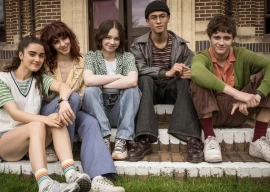
The spoken word distinguishes us from animals and the rest of creation. Yet, as the mobility and intermingling of peoples of many languages increases worldwide, man seems to be erecting a Tower of Babel once again. Take the example of the unfortunate metropolis of Karachi.
In 1941, more than half of the city’s less-than-400,000 population was Hindu and spoke Sindhi. At Partition, there was an upheaval: the majority of the Hindus left (or were driven away) and a tsunami of Urdu-speaking Mohajirs overwhelmed Karachi. By 1951, the proportion of Urdu speakers and Sindhi speakers had reversed. The amount of Pashto and Balochi speakers each remained under eight per cent.
Over the next three censuses, the proportion of Urdu speakers in the city peaked at over 50 per cent but the Pashto speakers slowly began to increase. In the 1998 census, in a population of 9.8 million, the Urdu speakers showed a declining trend of around 45 per cent while the Pashto speakers moved upwards to ten per cent.
Projecting these trend lines into the future, in less than thirty years the number of Pashto speakers will exceed the number of Urdu speakers. This overtaking period may be shorter owing to a number of factors: increasing Pakhtun rural-urban migration (including refugees from the 2008 Swat/Fata militancy, which is still ongoing, and displacement caused by the 2005 earthquake and the 2010 floods) to a city where ‘rupee notes grow on trees’, and increasing education levels and reduced birth rates among Mohajirs. The trend for the Sindhi-speaking population has also ramped up slightly (exacerbated by the 2010 flood and the 2011 rain-generated relocations).
In 2008, the Awami National Party was able to secure two provincial assembly seats in the Karachi stronghold of the Muttahida Qaumi Movement. The nationalist Sindhi parties (and the Pakistan Peoples Party?) are becoming restive as they find themselves overpowered by non-Sindhi speakers in their native province. In a country where no political party has a meaningful manifesto (except ‘retain the status quo’ and ‘get rich quick’) and voting is generally along ethnic or biradari lines, these changes in demographics augur badly for the party of Urdu speakers. Today, in a population of 15 to 18 million, the ‘language’ of political discourse has escalated to blind violence: in Karachi, a ‘peaceful strike’ or ‘mourning’ means that citizens are forced not to go to work, close businesses/factories, kill members of rival ethnic groups, burn buses and petrol stations — show them who is the boss!
Is it not obvious to all speakers of various languages in Karachi, that if they do not find a common ‘language’ of communication (aside from violence and blame), it may mean the end of everything for everyone? Efforts to grab or retain a larger share of the cake may result in no cake being available for anyone. Past efforts for peace by the groups themselves, by the government and by the judiciary have borne only temporary fruit.
Let us be sensible: Karachiwallahs need to simplify their lifestyles and aspirations, spread the wealth, control populations and realise that we must be smart and speak a common ‘language’ that promotes living together in peace and harmony.
Published in The Express Tribune, April 17th, 2012.
COMMENTS (33)
Comments are moderated and generally will be posted if they are on-topic and not abusive.
For more information, please see our Comments FAQ









































good to see Pakistanis acknowledge the attrocities commited against hindus.
The population of Mahajirs is 45% in Karachi? Is this writer out of his mind? If the Mahajir population was around even 50%, the MQM would never enjoy the dominating mandate it currently does in Karachi, Hyderabad, and Mirpurkhas. The truth is, Mahajirs makeup 75% of Karachi's population, 65% of Hyderabad, and 52% of Mirpurkhas. In terms of the ANP getting two seats in Karachi, let me just remind the readers and this brilliant writer, that the entire world knows those seats were handed over to the ANP by members of the Establishment, who are very anti-MQM. I had never even heard of the name ANP growing up in Karachi. If anyone holds considerable power in Karachi after the MQM, I would honestly say it's the Jamaat-e-Islami, followed by PPP, but no party or ethnic group even comes close to matching the strength of the MQM or Mahajirs in Karachi. I don't know who these people are trying to fool here with their twisted and engineered studies relating to demographics. Karachi is and always will be a Mahajir city, and the need for a Mahajir province is increasing by the day.
More relevant is "what is Karachi today?" and where do we go from here.
Look at Dubai for example. A city built by mohajirs aka expatriates of all faiths and ethnics backgrounds. A good development plan backed by vision can tranform a place. Fishing and pearl diving was done in 1950's in Dubai. But thats history. Today Dubai has claimed a spot in the tourist map of the world.
Success stories are aplenty. We have to join hands to excel. Mohajir bashing is certainly not the answer.
In earlly 1900 karachi was just a fishing market nothing else.
Urdu speaking population are well educated and have the ability to create wealth. They have built Karachi that got the nick name of "City of Lights". Migration makes your hardy and rock solid. One has to make it happen as no wheat and rice is grown by you in the fields of Sindh and Punjab. Keep up the hard work! Wealth will keep kissing your feet. There is no short cut to success.
Illegal property has never made anyone rich. Riches have to be earned.
I 100% agree with what the Karachiwala said. Urdu speaking community indeed make up the middle class and lower middle class of this country.
Also they are also the ones who principally get more education than other communities.
@Shakir Lakhani: None, what so ever. With some effort it can surely be compiled.
Town planners work today with approximated statistics so do the social scientists. However, I am sure if Karachi University in coordination with local bodies launches a project to collect all possible relevant data, say about the housing situation in the Metropol. Digitization would be a handy tool. The material then can be used by experts and can be made accessible to general public too.
Is there any document which proves that half the inhabitants of Karachi in 1947 were Hindus? How many Hindus live in Karachi today?
There was also a large Gujarati and Marathi speaking Hindu population in Karachi. Most left for India after partition. There is a small Marathi and Gujarati speaking Hindu population still.
There are some studies charting out the population break down of Karachi on 14 Aug 1947. Roland D'Souza being active in Shehri (NGO), presumbly can provide details on this.
At the time of independence roughly 400,000 inhabitants were composed of the following groups.
Parsis Roman Catholic Christians (Goans) Jews Sikhs Marwaris Memons/Gujratis Chhechis (Lower caste Hindus with origin in Rajputana) Seraikis from Mianwali district Balochis/Makranis/Sheedis Some English and Poles Sindhi Hindus (Not all but many left after the division) Sindhi Muslim (Many landowners had an extra house in Karachi, middle class and poorer class were negligible in numbers)
There is no proper data assembled at one place, which was collected with the help of old KMC records, indicating the change of ownership legally or occupied illegally after 1947. Exactly how many and which properties were declared evacuee? Several properties allotted to new occupants, a good percentage were not migrants from India.
Huge shanty towns sprung up in different parts of the city which accommodated the overwhelming majority of refugees.
Zulfiqar Mirza and his ilk can go on repeating, how refugees were welcomed by open arms. But is there much truth in it?
@Ali Tanoli: "Ports are the reason for those peoples getting rich. not the peoples."
Oh God! Really sorry but this statement indicates the narrow-minded of yours. This sums up what you are sowing in your heart . Actually what? I don't find all Mohajir as 'Rich & Wealthy' in fact they still make up the middle class and lower-middle class of the the population.
@Ali Tanoli: "...i am born and raised in karachi with karachi sindh domicile why i am not karachiete ..."
I don't know who considers you Non-Karachite but I have friends, Sindhi, Punjabi and Hindus too and they all belong to Karachi and neither I nor they themselves think of this rubbish. We studied together right from school till Undergraduate level and had a wonderful time together. We all belong to ordinary families and none of us are narrow-minded.
Perhaps, you don't like the tone of my comments but I responded in this manner only when you try to invent the history by stating a falsity about forceful migration of Hindus from Karachi and unethical conquest of their land and property by Mohajirs. This is totally rubbish and based on falsehood stories. It never happened. and by the way have you ever visited the areas like Dohli- Khata, Ram Swamy, Ankle Saria Hospital, Empress Market and Gurumandir etc? Many Hindus are still leaving there and if you still have doubts then go and interview them personally.
Ports are the reason for those peoples getting rich. not the peoples.
@Karachiwalla, Bhai i am from karachi too why u peoples called city of urdu speakers i am born and raised in karachi with karachi sindh domicile why i am not karachiete i had a fight on this topic one time and if the karachi generating more wealth for the country because it is port city and all over the world there port cities generats more them and no one say that certain community does that if new york make more its not the jews are reason or mumbai makes for india its not that malabaris or gujrathis bunys are reason its a majic of port.
@Ali Tanoli: Who is that 'Someone' by the way? FYI! Nothing has been burnt elsewhere and no one has been killed and nobody was forced to migrate from Karachi. Hindus who were living here migrated by their own choice while Mohajireen (who were mainly forced to leave) re-established the city and which is, in a very short span of time become a economic powerhouse and a financial hub for the entire country.
I suggest you to find this 'Someone' and verify his/her facts and please read the history in detail. Huh! suni sunayii baatoon ko Fact samjhna bewaqoofi hai.
@Ali, Bangalis used to say the same thing what Biharis in karachi starts saying that karachi generat 20% of the country and bangali were saying west pakistan runs on Putson.
I hope my comment will get place in this article of D.souza sahab of empress market and he is right when he said about forced migration of local hindus sindhi.
@M.Ahmed sahab. Abbotabd was english city there was christian peoples were living with local christian population and they still exist we never forced them to converts or migrate.
@M. Ahmed, In Hari pur main bazaar sikh properties alloted to muhajirs of dehli basti nizamuddin and Rawalpindi do the same and in lahore there many urdu speakers who got properties in anarkali and kashmiri, mochi gate area and the same way muhajirs got and lived in peshawer, mardan, saray alamgir, sarai muhajir in south punjab even in bahal pur there are bunch of em and by the way in karachi all whole old is in muhajir hands even pathan were allowed to enter that time they were living that time too in the city of hindus sindhi and one more thing liaqat abd and orangi town are 1954 muhajirs and even after that untill 1971 war muhajirs were coming still and getting the land permits my dad told me they were given the perchi for there plote in the morning and they sell to pathan or punjabis and again sid in the line for another one in the time of ayub khan who is too bad in the eyes of urdu speakers and he was the one who was great to them if u need details i have it i can do it.
We generate revenue of Pakistan upto 72%, we accommodate people from all over Pakistan and still we need to control our population. lol
@ Ali Tanoli
Shame on all those who benefitted from the illegal occupation of properties in 1947 left by Hindus and Sikhs all over Pakistan.
Hindu properties in Sindh and Sikh properties in the Punjab went to the workers of Muslim League . The Punjab Evacuee Trust Board looks after the property in Punjab. Sikh property was concentrated in Nankana Sahib, Panja Sahib, Hassan Abdal as well as Hazarwal particularly Abbottabad. Who is enjoying and benefitting from that property?
There is still a hindu temple in Raja Bazar, Rawalpindi that is now a book store. Shame on the occupant!
The bulk of the muslims of UP and Bihar were rehabilitated in Liaquatabad in 1947 and Orangi Town in 1971.
Some one told me long time ago about forced migration of karachi local hindu population i could not believe it that when urdu speakers came from U.p and bihar they did it and ocupies the property of bahdar road and saddar empress market and burns road, gharader, methader, and also in hyderabad and other cities in sindh what a shame... no wonder they are rich now.
Here lies the point: a non-muslim insist upon all the deeds that are laid down in Islam while Muslims are doing otherwise. I have always admired Roland and his dedicated approach towards Karachi. He is a real Karachiite far better than our so called leaders.
a common language of interest i beleive, otherwise a common language of communication has already taken its toll in form of bangladesh. so, lets not impose it again.
Who will listen to you, SIR? All the stakeholders and the people who matter; need to read this article to get some insight and political vision for developing political will to do something for the nation. Karachi is symbol of our society and country; if moves in the right direction the whole nation will follow.
A Peshawary
I hope this was pointed at the political parties. Else, I would be very mad at the writer for such 'holier than thou' statements.
The common ''language'' is Karachi free of arms, equal political, social and economic rights for all Karachites and rule of law with undiluted democracy in practice.
Spread the wealth? Karachi pays 70% of tax collected in Pakistan. Karachi paal raha hey aur Pakistan ko.
The common ''language'' -- is Karachi free of arms, equal political, social and economic rights for all Karachites and rule of law with undiluted democracy in practice.
Very well said it Mr D,souza. we hope.